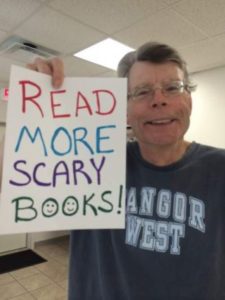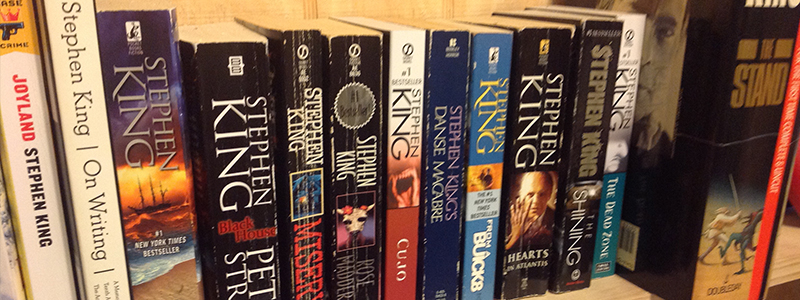The plan is to reread all of Stephen King’s novels and collections and assorted other publications in their order of publication. Richard Chizmar of Cemetery Dance set out the challenge for himself and invited others to join in. It is an idea which indulges my obsession with King’s writing. I’m doing it because I am a writer and I want to improve my long fiction and storytelling. I think there are secrets to be discovered or rediscovered in it too. As Chizmar posts his after read posts and Bev Vincent posts his accompanying history, I will add links to those in my corresponding posts.
Here is Bev Vincent’s historic essay.
Here are Richard Chizmar’s thoughts.
You can also go back to the beginning and read Before Carrie and follow all the blog posts through each book.
Here is the link the Master List of all my #StephenKingRevisited posts.
Much of what I write in these posts will really be notes for me. I will do my best to make them into coherent observations for you. I will also style my comments to be as spoiler free as possible for those who haven’t read the book, but in a way which will also work for those who have read the books. Be warned though that I am discussing the content of the book and the writing.
So, let’s join in the Danse Macabre.

Getting a paperback copy from 1981, the extra material is interesting and nostalgic. He states there are lots corrections between the hardback and the paperback apparently. This old copy had words faded out of it in a couple spots. I had to work to piece together a couple sentences. There’s a Clive Barker ad in the back. Some of the “current” references in the book are time capsules themselves. There are tributes throughout the book to living authors who are no longer alive now. Yet, much of the book is universal and timeless to understanding horror. Other bits are firmly nested where and when the book was written. Overall, it holds up well.
Late in the book as King talks about real life horrors such as Jonestown and terrorism and threat of nuclear war, he makes an aside joke that I believe he viewed as a joke at the time (he added a “HaHa”) talking about what a particular author would mean to the 80’s and King then quips, “If there is a 1980’s.” People make similar asides today about the potential end of the world now. I wonder if a time traveler from the 1980’s, not just someone who lived through it and had thirty years to absorb it, but someone instantly transplanted, would view our international scene as threatening in comparison to their fears when they were current. Sure, there are new threats and the communication by social media would be mind-boggling even without the comment sections, but I bet those who feared the annihilations of the 1980’s might breathe a sigh of relief at some of the threats we face today. And might we do the same if transported thirty years in the future to see that we survived our fears of today even in light of what disturbs future contemporaries?
“Enter at your own Riske: Here there be Tygers,” King warns. All great warnings go wild with spellings and capitalization. Thus, Danse Macabre. The inspiration for writing this “recent” history of horror came from a number of places and the prodding of particular people. One seed for the book was planted watching the 1978 All Star Game on a big screen in an Irish Pub. Fiction is flexible lies while nonfiction requires respect for the facts, King says. A novelist can be in the background with his puppets performing the show. Nonfiction writers are more visible, so King feels a bit exposed in writing Danse Macabre. No one truly knows what they believe on a subject until they’ve written their thoughts down. This sentiment from King makes me wonder if writing Danse Macabre was less about filling an obligation to a few nagging members of the industry and more about him finding his own way forward from where he stood at a place of great success, but still very early in his career. He tells us, the readers, that he hopes we find the trip not without its compensations.
This whole exercise brings to mind Brian Keene’s current attempts at the history of horror in his ongoing columns. The most recent release of those centers around Jack Ketchum after the recent loss of this great mind and creator. Danse Macabre was written relatively early in King’s writing career. On Writing, written by King after his devastating accident with the van, is closer to the perspective of Keene in his current attempts. King talked about the past, but focused large portions on the current trends as they presented themselves at the beginning of the 1980’s. It was wild to see Ramsey Campbell discussed as a young writer and part of a new generation of the horror genre. Keene will discuss what is current as well in his history of horror too, but he is further toward the other end of his career as he contemplates the genre. Keene stands closer to On Writing than he does to Danse Macabre. His mind for some time has been in deep contemplation on the meaning and place of those who are stepping off the stage and how to properly preserve their legacies. At the same time, this drives Keene to embrace members of the current generation of writers and shepherd them forward. Danse Macbre is rare in this sense not only because it is written by an undeniable force in the genre, not only because it is comprehensive in its scope, and not only because it pays interesting commentary and full academic and historic respect to the place of horror, but because it is all those things and penned by a master of the genre with the majority of his career still ahead of him. As I reread all of King’s books in order as fast as I can between dying, kidney transplant, recovery, rejection, recovery, etc., I make a rough count of ten volumes on my shelf leading up to Danse Macabre and some sixty-five and counting to the right. This feat may never be repeated for this or any other genre or industry.
King talks about that all important first contact in the industry that all new writers need and wait for. Becoming a writer is a direct result of conscious will by the individual, he declares.
Horror works on two levels: Gross out and the more subtle dance. In the dance, he says here, horror is the art and creates it by using phobic pressure points. Stuff we didn’t know other people knew about us. The “Danse Macabre” may be combing the conscious and subconscious mind around one potent idea. Horror is a private secret combat in the recesses of the heart. His sense of horror is already well developed here and is not much different than how he expresses in it in On Writing decades later. Terror is the sound of the Tell Tale Heart. Horror is seeing the horrible thing. The viscera is engaged as we descend into revulsion.
Horror stories go into two further categories. The horror arises from an act of will – a conscious choice of evil. The other is predestined by great forces outside. Dracula succeeds in making the outside evil familiar.
How is horror best presented? Never open the door at all, so that you don’t ruin the worse image the reader invented in their head? Open it just a crack? He discusses the horror of radio vs. video in this regard. The horror of climbing the staircase vs. the possible letdown of the actual reveal. If the creature is ten feet it is less than the hundred feet the reader imagined while on the stairs. If the author expands it to a hundred feet, had the reader imagined a thousand more instead?
King tells the story of being a kid and having the announcement made about Sputnik in the middle of an afternoon showing of The Earth vs The Flying Saucers. The terror on the adult’s face telling this to kids and coupled with the imagined terror of alien invasion being portrayed on the screen. War babies like King understood and were primed for the transition from the hopeful, pioneering spirit of science fiction into horror.
In the attic, he and his brother find their father’s things. They found shipboard things and film. They rented a projector and their father unknowingly waves at sons not yet born who he would leave very young. They also found his father’s old books. Horror-fantasy there, but not his first introduction to it. Lovecraft cast a shadow. The books disappeared after a couple weeks. He suspects his aunt took them back, but the course was set and King was reading the stuff. There is a great line in this section about chicken skeletons in the third loft of the barn and some secret in their dark sockets.
King has a great love for Lovecraft’s work and recognizes the impact it had on his development as a writer. King implies Great Cthulhu is Lovecraft’s fear of female sexuality. He also mentions Lovecraft was fascinated with bad geometry as part of horror and madness. This comes into play in the “Bad Place” and haunted house discussions in the book.
He talks about children’s minds and the horror to be found hidden within the Disney films we show our kids without a second thought. He took Joe to see “Creature from the Black Lagoon” at age five. There was something about seeing it as a child which did not translate clean into adulthood. Suspension of disbelief is different in childhood – almost built-in.
He discusses how he and his friends were fascinated with the decay of a dead cat on the road for quite some time. It is an interesting display of how children see and investigate death.
His goal or his desire in creating horror or experiencing it is “the outletting.” He prefers this idea to the full meaning of catharsis. Secrets are left untold and things best left unsaid. The author promises to tell the secret.
He uses “drowsing” as a symbol for convincing the audience and readers to suspend disbelief. He then uses it as a symbol for talent in writers which is in need of refining. Disbelief isn’t light. It’s heavy. Suspending disbelief is difficult.
The game of definition with genre is a trap and he can’t imagine a more boring academic subject. Horror writers must know the line between the socially, morally, and psychologically acceptable and then the great white space of the taboo beyond.
Dr. Jekyll and Mr. Hyde is the real werewolf story as King categorizes monsters. The Mark of the Beast. He also talks broadly about the trope of the vampire and the other. Human characters can be used within these constructs. Other creatures and inventions can substitute for these tropes, but serve the exact same role. He also discusses the break between reason and chaos within the workings of horror.
King’s assessment of TV in the 80’s is interesting in light of the current state of streaming. King lamented that drama may have been dead on TV by the time of this book’s publication. I wonder what he thinks now.
There is an entire appendix of books King thinks readers of the era should check out. Within the discussion of the text though, he mentions that the absolute essentials of the time are Ghost Story by Peter Straub, Rosemary’s Baby, The Exorcist, and The Other.
King discusses haunted houses in terms of the concept of the “Bad Place.” Piano chords and psychic batteries and the idea behind The Shining. He speaks positively of Kubrick’s version of The Shining more than once through here. Either he believed that at this point in his career or he was holding back his true reservations about the film which he expressed later in life.
The “Bad Place” in American gothic was once seen as the womb. It was a way to address sexual fears. More modern cities suggest it is a fear and reflection of self – a symbolic mirror.
Rosemary’s baby and urban paranoia are discussed. “The perfect paranoia is perfect awareness.” With Body Snatchers, “paranoia is the last refuge of our strained minds.” Maybe all horror stories then are about disorder and the fear of change.
Anne Rivers Siddons speaks in reference of the 1978 The House Next Door and says, “For belief is everything; belief is all. Without belief, there is no terror.”
King says there is something lush and fertile in the Southern imagination.
He discusses Something Wicked This Way Comes before it became a movie in the 80’s. King reveals some of his thoughts which may indicate the seeds of what would become his novel Needful Things.
King suggests James Herbert’s The Fog may have successfully predicted the horror that was to be found in the Jonestown massacre. Also in that book, a plane is crashed into a London skyscraper which might contemplate the horror which was to be found in 9/11. King borrows that same concept for the ending of The Running Man. His point in this is that if people wrote current events as horror stories any number of years in the past, they would be seen as too far-fetched. Commentators after Jonestown stated no one could have imagined the horror of this before now, but King points out that Herbert did.
Erle Stanley Gardner was paid one cent per word for pulp westerns at the height of the Great Depression. It’s sad that that is still considered good money for writing today in 2018. Writers then started writing “Bang Bang” instead of just “Bang” in order to get the extra penny. “More bang for your buck” you might say.
King wrote a two page footnote in his section on Harlan Ellison. He might as well have just included it in the main text.
He mentions he couldn’t sell the story “Survivor Type” about self-cannibalism. It would appear in a much later collection.
“He thrusts his fists against the posts …” This mantra is used in King’s novel It later. The phrase originally appeared in the story of Donavan’s Brain.
King alludes to Pet Semetary as an upcoming story where he did funeral research though he does not mention the story by name.
He makes reference to leeches on the skin which will show up in his story “The Body.”
He refers often to Republicans negatively like a monster trope.
“All of us are mentally ill. Some of us just hide it better.” Great line.
King uses zestfully in Danse Macabre on page 364 in my addition. He did it before with “zest” in Salem’s Lot in chapter 3, section 6 in the last sentence of that section. These jump out at me now because of how he described hating that word because of its overuse in a particular sci fi story. I think he tossed it in a couple places on purpose and then forgot about it.
King closes off with an odd section where he intercuts some of his own discussions of horror with the press and accounts of people doing horrible things and then later connecting those things to horror books and movies. It is an interesting aside at the end which leaves readers to draw their own conclusions.
There is obviously so much more to glean and absorb from this book. It is rich with detail about important films and books and more in how it all relates to the genre and to all of us. As with King’s sentiment, I hope you found something worth the time here.
Next up, will be Cujo and my Before Cujo post.
— Jay Wilburn, still trying to learn about horror what Stephen King knew forty years ago.





